Organizational Change and Leadership: ANZ Banking Group Case Study
VerifiedAdded on 2020/04/01
|15
|3918
|740
Case Study
AI Summary
This case study examines the change management strategies implemented at ANZ Banking Group, focusing on the transformational changes undertaken to rationalize the organizational structure and embrace new values. The analysis explores the application of change management theories, specifically Lewin's three-stage model and the McKinsey 7S model, to guide the organizational change process. The study highlights challenges faced by managers, such as resistance to change and ineffective communication, and discusses the importance of leadership styles, particularly visionary and transformational approaches, in ensuring successful implementation. It also covers the use of cultural web and ADKAR models to facilitate a smoother transition for employees. The case study provides insights into specific leadership attributes and the impact of these changes on the bank's performance and culture. The study emphasizes the importance of clear communication, employee engagement, and a focus on long-term goals in driving successful organizational change. This case study is valuable for understanding change management in the banking sector.
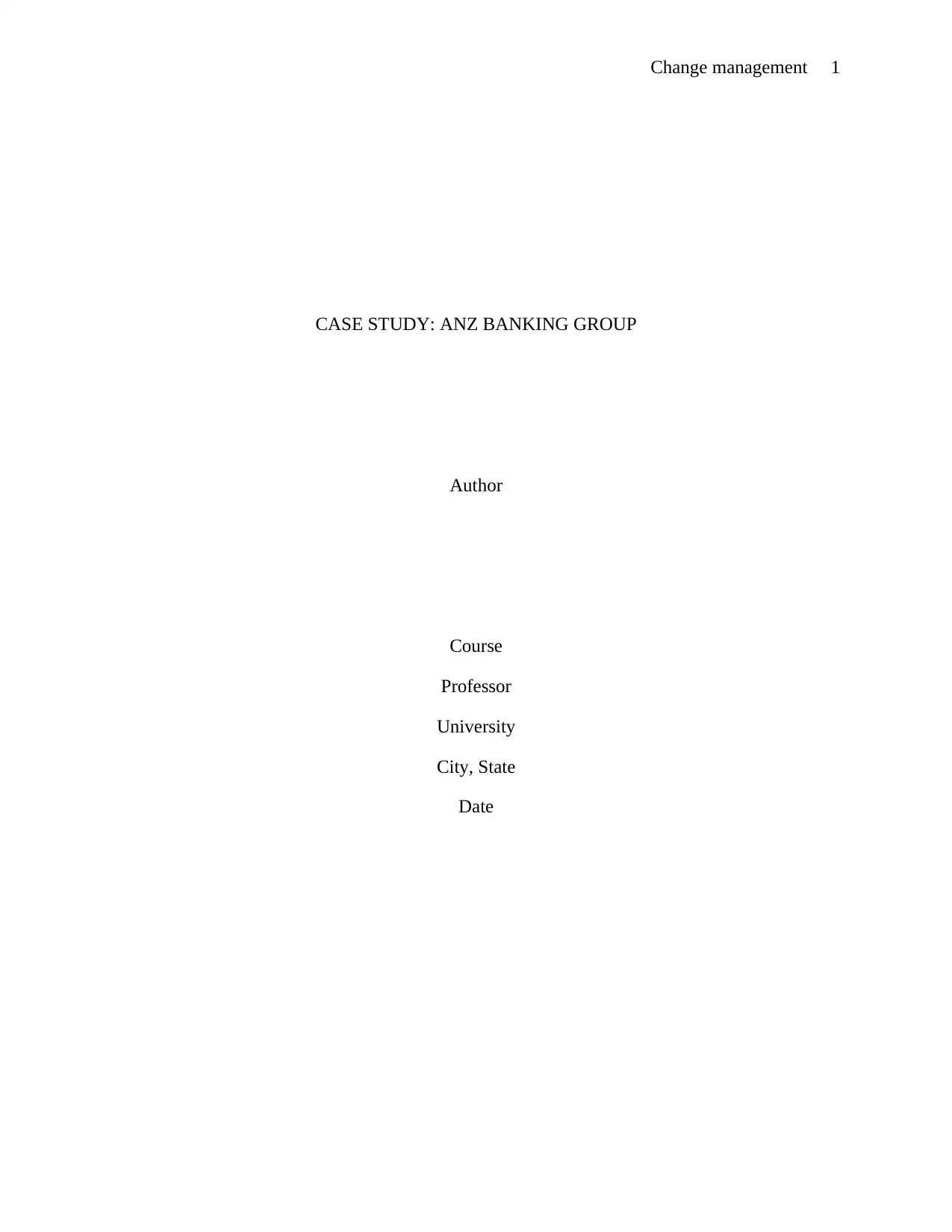
Change management 1
CASE STUDY: ANZ BANKING GROUP
Author
Course
Professor
University
City, State
Date
CASE STUDY: ANZ BANKING GROUP
Author
Course
Professor
University
City, State
Date
Paraphrase This Document
Need a fresh take? Get an instant paraphrase of this document with our AI Paraphraser
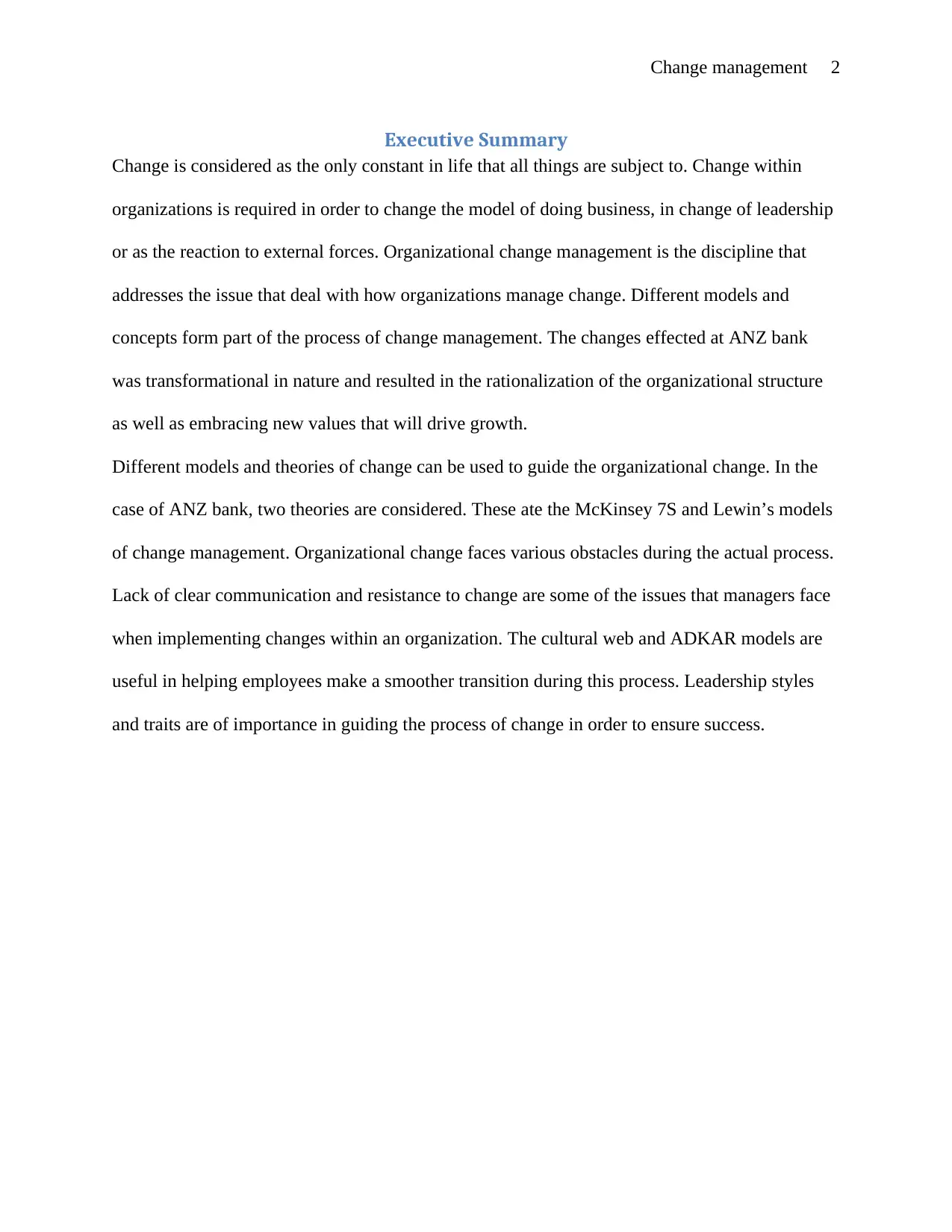
Change management 2
Executive Summary
Change is considered as the only constant in life that all things are subject to. Change within
organizations is required in order to change the model of doing business, in change of leadership
or as the reaction to external forces. Organizational change management is the discipline that
addresses the issue that deal with how organizations manage change. Different models and
concepts form part of the process of change management. The changes effected at ANZ bank
was transformational in nature and resulted in the rationalization of the organizational structure
as well as embracing new values that will drive growth.
Different models and theories of change can be used to guide the organizational change. In the
case of ANZ bank, two theories are considered. These ate the McKinsey 7S and Lewin’s models
of change management. Organizational change faces various obstacles during the actual process.
Lack of clear communication and resistance to change are some of the issues that managers face
when implementing changes within an organization. The cultural web and ADKAR models are
useful in helping employees make a smoother transition during this process. Leadership styles
and traits are of importance in guiding the process of change in order to ensure success.
Executive Summary
Change is considered as the only constant in life that all things are subject to. Change within
organizations is required in order to change the model of doing business, in change of leadership
or as the reaction to external forces. Organizational change management is the discipline that
addresses the issue that deal with how organizations manage change. Different models and
concepts form part of the process of change management. The changes effected at ANZ bank
was transformational in nature and resulted in the rationalization of the organizational structure
as well as embracing new values that will drive growth.
Different models and theories of change can be used to guide the organizational change. In the
case of ANZ bank, two theories are considered. These ate the McKinsey 7S and Lewin’s models
of change management. Organizational change faces various obstacles during the actual process.
Lack of clear communication and resistance to change are some of the issues that managers face
when implementing changes within an organization. The cultural web and ADKAR models are
useful in helping employees make a smoother transition during this process. Leadership styles
and traits are of importance in guiding the process of change in order to ensure success.

Change management 3
Table of Contents
Executive Summary.....................................................................................................................2
CASE STUDY: ANZ BANKING GROUP....................................................................................4
Theories applicable......................................................................................................................4
Lewin’s theory.........................................................................................................................4
The McKinsey 7S model.........................................................................................................5
Challenges for managers in implementing transformation strategies..........................................7
Specific leadership attributes in the case study...........................................................................9
Conclusion.................................................................................................................................11
References..................................................................................................................................12
Table of Contents
Executive Summary.....................................................................................................................2
CASE STUDY: ANZ BANKING GROUP....................................................................................4
Theories applicable......................................................................................................................4
Lewin’s theory.........................................................................................................................4
The McKinsey 7S model.........................................................................................................5
Challenges for managers in implementing transformation strategies..........................................7
Specific leadership attributes in the case study...........................................................................9
Conclusion.................................................................................................................................11
References..................................................................................................................................12
⊘ This is a preview!⊘
Do you want full access?
Subscribe today to unlock all pages.

Trusted by 1+ million students worldwide
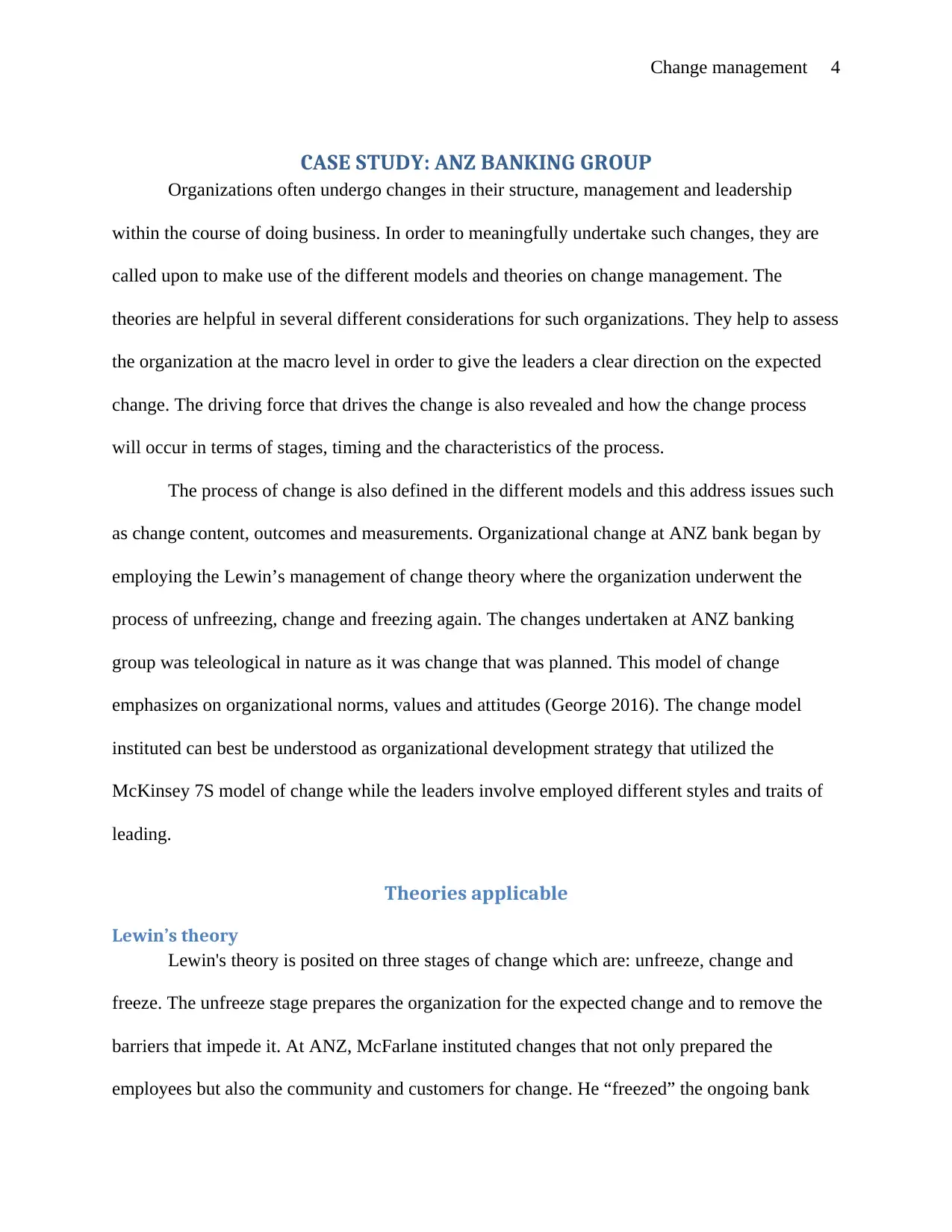
Change management 4
CASE STUDY: ANZ BANKING GROUP
Organizations often undergo changes in their structure, management and leadership
within the course of doing business. In order to meaningfully undertake such changes, they are
called upon to make use of the different models and theories on change management. The
theories are helpful in several different considerations for such organizations. They help to assess
the organization at the macro level in order to give the leaders a clear direction on the expected
change. The driving force that drives the change is also revealed and how the change process
will occur in terms of stages, timing and the characteristics of the process.
The process of change is also defined in the different models and this address issues such
as change content, outcomes and measurements. Organizational change at ANZ bank began by
employing the Lewin’s management of change theory where the organization underwent the
process of unfreezing, change and freezing again. The changes undertaken at ANZ banking
group was teleological in nature as it was change that was planned. This model of change
emphasizes on organizational norms, values and attitudes (George 2016). The change model
instituted can best be understood as organizational development strategy that utilized the
McKinsey 7S model of change while the leaders involve employed different styles and traits of
leading.
Theories applicable
Lewin’s theory
Lewin's theory is posited on three stages of change which are: unfreeze, change and
freeze. The unfreeze stage prepares the organization for the expected change and to remove the
barriers that impede it. At ANZ, McFarlane instituted changes that not only prepared the
employees but also the community and customers for change. He “freezed” the ongoing bank
CASE STUDY: ANZ BANKING GROUP
Organizations often undergo changes in their structure, management and leadership
within the course of doing business. In order to meaningfully undertake such changes, they are
called upon to make use of the different models and theories on change management. The
theories are helpful in several different considerations for such organizations. They help to assess
the organization at the macro level in order to give the leaders a clear direction on the expected
change. The driving force that drives the change is also revealed and how the change process
will occur in terms of stages, timing and the characteristics of the process.
The process of change is also defined in the different models and this address issues such
as change content, outcomes and measurements. Organizational change at ANZ bank began by
employing the Lewin’s management of change theory where the organization underwent the
process of unfreezing, change and freezing again. The changes undertaken at ANZ banking
group was teleological in nature as it was change that was planned. This model of change
emphasizes on organizational norms, values and attitudes (George 2016). The change model
instituted can best be understood as organizational development strategy that utilized the
McKinsey 7S model of change while the leaders involve employed different styles and traits of
leading.
Theories applicable
Lewin’s theory
Lewin's theory is posited on three stages of change which are: unfreeze, change and
freeze. The unfreeze stage prepares the organization for the expected change and to remove the
barriers that impede it. At ANZ, McFarlane instituted changes that not only prepared the
employees but also the community and customers for change. He “freezed” the ongoing bank
Paraphrase This Document
Need a fresh take? Get an instant paraphrase of this document with our AI Paraphraser
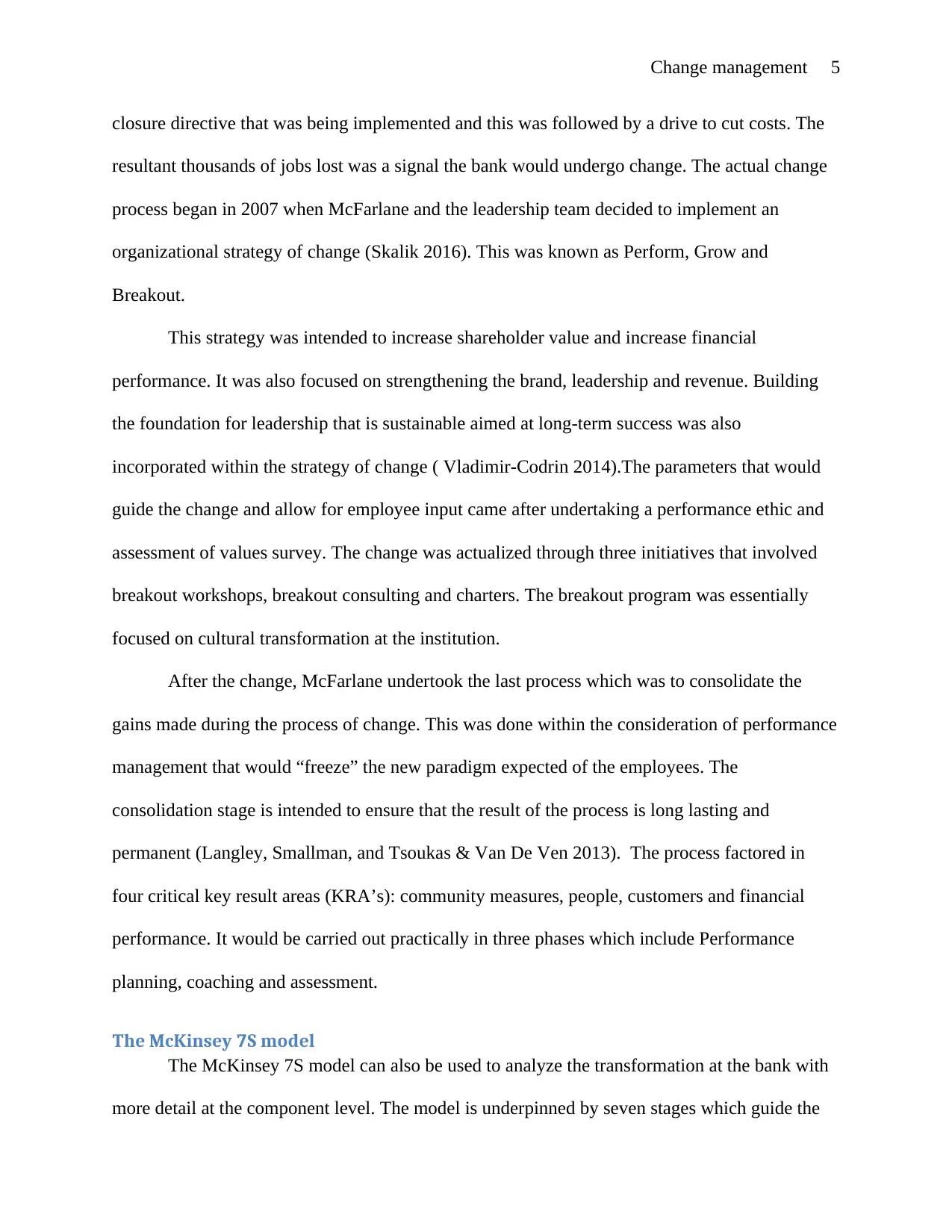
Change management 5
closure directive that was being implemented and this was followed by a drive to cut costs. The
resultant thousands of jobs lost was a signal the bank would undergo change. The actual change
process began in 2007 when McFarlane and the leadership team decided to implement an
organizational strategy of change (Skalik 2016). This was known as Perform, Grow and
Breakout.
This strategy was intended to increase shareholder value and increase financial
performance. It was also focused on strengthening the brand, leadership and revenue. Building
the foundation for leadership that is sustainable aimed at long-term success was also
incorporated within the strategy of change ( Vladimir-Codrin 2014).The parameters that would
guide the change and allow for employee input came after undertaking a performance ethic and
assessment of values survey. The change was actualized through three initiatives that involved
breakout workshops, breakout consulting and charters. The breakout program was essentially
focused on cultural transformation at the institution.
After the change, McFarlane undertook the last process which was to consolidate the
gains made during the process of change. This was done within the consideration of performance
management that would “freeze” the new paradigm expected of the employees. The
consolidation stage is intended to ensure that the result of the process is long lasting and
permanent (Langley, Smallman, and Tsoukas & Van De Ven 2013). The process factored in
four critical key result areas (KRA’s): community measures, people, customers and financial
performance. It would be carried out practically in three phases which include Performance
planning, coaching and assessment.
The McKinsey 7S model
The McKinsey 7S model can also be used to analyze the transformation at the bank with
more detail at the component level. The model is underpinned by seven stages which guide the
closure directive that was being implemented and this was followed by a drive to cut costs. The
resultant thousands of jobs lost was a signal the bank would undergo change. The actual change
process began in 2007 when McFarlane and the leadership team decided to implement an
organizational strategy of change (Skalik 2016). This was known as Perform, Grow and
Breakout.
This strategy was intended to increase shareholder value and increase financial
performance. It was also focused on strengthening the brand, leadership and revenue. Building
the foundation for leadership that is sustainable aimed at long-term success was also
incorporated within the strategy of change ( Vladimir-Codrin 2014).The parameters that would
guide the change and allow for employee input came after undertaking a performance ethic and
assessment of values survey. The change was actualized through three initiatives that involved
breakout workshops, breakout consulting and charters. The breakout program was essentially
focused on cultural transformation at the institution.
After the change, McFarlane undertook the last process which was to consolidate the
gains made during the process of change. This was done within the consideration of performance
management that would “freeze” the new paradigm expected of the employees. The
consolidation stage is intended to ensure that the result of the process is long lasting and
permanent (Langley, Smallman, and Tsoukas & Van De Ven 2013). The process factored in
four critical key result areas (KRA’s): community measures, people, customers and financial
performance. It would be carried out practically in three phases which include Performance
planning, coaching and assessment.
The McKinsey 7S model
The McKinsey 7S model can also be used to analyze the transformation at the bank with
more detail at the component level. The model is underpinned by seven stages which guide the

Change management 6
process of change (Nielsen & Abdilgaard 2013). These are: strategy, structure, systems, shared
values, style, skills and staff. The strategy embraced by the leadership of ANZ bank was named
as Perform, Grow and Breakout. The structure of ANZ is split into five divisions which work in
collaboration as one. These are the Shared services, Institutional and those based in New
Zealand, Asia Pacific and Australia. The structure of reporting is interactive with the line
managers through the Performance Assessment that is done yearly.
The process of change focused on developing the skills of the employees through
programs such as the Emerging Leader Radar Talent which is run by line and HR managers.
Additionally, the bank runs a graduate trainee program which allows for the graduate to develop
a skill set that is broad in order to have a better understanding of the business. The focus is to
develop leadership potentials of the employees (Campbell 2014). Staff considerations are based
on controlling the volume while increasing productivity based on the banks balance sheet paying
for performance. The philosophy on staff is to have fewer employees who are better paid and
more productive.
The style taken by the managers at the higher echelons is the one of coaching the
employees. The managers are expected to implement long-term development plans for the
employees in order to ensure they have learning opportunities and support in order to succeed in
their jobs (Farrell 2015). The process of change resulted in shared organizational values which
include integrity, collaboration and accountability. Other values espoused are respect and
excellence both at the organizational and personal level. Quantz et al (2017), states that these
values drive the organizational culture where the employee is expected to perform at their best
and factor in the best interests of all stakeholders.
process of change (Nielsen & Abdilgaard 2013). These are: strategy, structure, systems, shared
values, style, skills and staff. The strategy embraced by the leadership of ANZ bank was named
as Perform, Grow and Breakout. The structure of ANZ is split into five divisions which work in
collaboration as one. These are the Shared services, Institutional and those based in New
Zealand, Asia Pacific and Australia. The structure of reporting is interactive with the line
managers through the Performance Assessment that is done yearly.
The process of change focused on developing the skills of the employees through
programs such as the Emerging Leader Radar Talent which is run by line and HR managers.
Additionally, the bank runs a graduate trainee program which allows for the graduate to develop
a skill set that is broad in order to have a better understanding of the business. The focus is to
develop leadership potentials of the employees (Campbell 2014). Staff considerations are based
on controlling the volume while increasing productivity based on the banks balance sheet paying
for performance. The philosophy on staff is to have fewer employees who are better paid and
more productive.
The style taken by the managers at the higher echelons is the one of coaching the
employees. The managers are expected to implement long-term development plans for the
employees in order to ensure they have learning opportunities and support in order to succeed in
their jobs (Farrell 2015). The process of change resulted in shared organizational values which
include integrity, collaboration and accountability. Other values espoused are respect and
excellence both at the organizational and personal level. Quantz et al (2017), states that these
values drive the organizational culture where the employee is expected to perform at their best
and factor in the best interests of all stakeholders.
⊘ This is a preview!⊘
Do you want full access?
Subscribe today to unlock all pages.

Trusted by 1+ million students worldwide

Change management 7
Challenges for managers in implementing transformation strategies
One of the challenges that managers are confronted with is the resistance to change
experienced with an organization. The bias against the change that prefers to maintain the status
quo originates due to several fears amongst the employees. Jiang, Probst & Benson (2014), state
that the fear could that of losing employment, working more for less pay or transfer to divisions
which may be far away. The resistance may be active or passive amongst the employees.
Smollan (2017), states that one approach for the manager would be to take time in informal
sittings where they can listen to the employees, communicate the intended change and prepare
them psychologically.
Another challenge is ineffective communication that results in the manager being
misinterpreted or misunderstood. This also leads to distrust with the employees. The lack of
effective communication may also affect the senior management. The remedial measure that
managers may be undertaken is to have a clear internal corporate communication strategy that is
clear in order to l address issues such as employee complaints and grievances, conflict which is
interpersonal and discipline during the process of change ( Nielsen & Randall 2012). Feedback
from employees should be appropriately communicated to the senior management and the
organizational leadership.
Another challenge is the strategy which focuses on cost cutting which may be beneficial
in the short- run but may prove to be short sighted in hindsight. An example is McFarlane who
bailed out of emerging markets in order to lower the risk profile of the bank. The bank was left
behind by its competitors in wealth management by the banks that had made significant
acquisitions. While trying to avoid making errors, there is the potential problem of being risk
averse which ultimately turns out to be negative in its outcomes. The change came at the cost of
Challenges for managers in implementing transformation strategies
One of the challenges that managers are confronted with is the resistance to change
experienced with an organization. The bias against the change that prefers to maintain the status
quo originates due to several fears amongst the employees. Jiang, Probst & Benson (2014), state
that the fear could that of losing employment, working more for less pay or transfer to divisions
which may be far away. The resistance may be active or passive amongst the employees.
Smollan (2017), states that one approach for the manager would be to take time in informal
sittings where they can listen to the employees, communicate the intended change and prepare
them psychologically.
Another challenge is ineffective communication that results in the manager being
misinterpreted or misunderstood. This also leads to distrust with the employees. The lack of
effective communication may also affect the senior management. The remedial measure that
managers may be undertaken is to have a clear internal corporate communication strategy that is
clear in order to l address issues such as employee complaints and grievances, conflict which is
interpersonal and discipline during the process of change ( Nielsen & Randall 2012). Feedback
from employees should be appropriately communicated to the senior management and the
organizational leadership.
Another challenge is the strategy which focuses on cost cutting which may be beneficial
in the short- run but may prove to be short sighted in hindsight. An example is McFarlane who
bailed out of emerging markets in order to lower the risk profile of the bank. The bank was left
behind by its competitors in wealth management by the banks that had made significant
acquisitions. While trying to avoid making errors, there is the potential problem of being risk
averse which ultimately turns out to be negative in its outcomes. The change came at the cost of
Paraphrase This Document
Need a fresh take? Get an instant paraphrase of this document with our AI Paraphraser
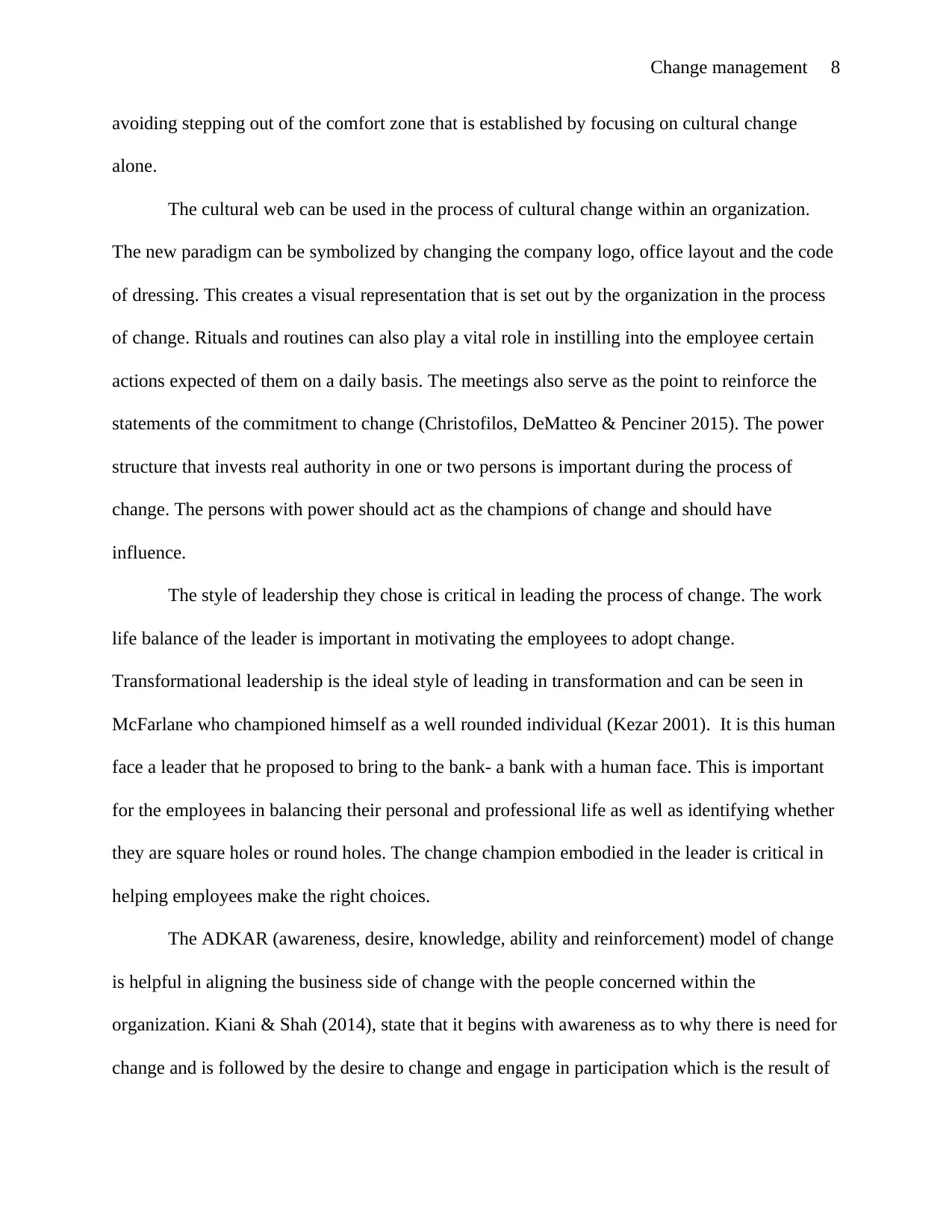
Change management 8
avoiding stepping out of the comfort zone that is established by focusing on cultural change
alone.
The cultural web can be used in the process of cultural change within an organization.
The new paradigm can be symbolized by changing the company logo, office layout and the code
of dressing. This creates a visual representation that is set out by the organization in the process
of change. Rituals and routines can also play a vital role in instilling into the employee certain
actions expected of them on a daily basis. The meetings also serve as the point to reinforce the
statements of the commitment to change (Christofilos, DeMatteo & Penciner 2015). The power
structure that invests real authority in one or two persons is important during the process of
change. The persons with power should act as the champions of change and should have
influence.
The style of leadership they chose is critical in leading the process of change. The work
life balance of the leader is important in motivating the employees to adopt change.
Transformational leadership is the ideal style of leading in transformation and can be seen in
McFarlane who championed himself as a well rounded individual (Kezar 2001). It is this human
face a leader that he proposed to bring to the bank- a bank with a human face. This is important
for the employees in balancing their personal and professional life as well as identifying whether
they are square holes or round holes. The change champion embodied in the leader is critical in
helping employees make the right choices.
The ADKAR (awareness, desire, knowledge, ability and reinforcement) model of change
is helpful in aligning the business side of change with the people concerned within the
organization. Kiani & Shah (2014), state that it begins with awareness as to why there is need for
change and is followed by the desire to change and engage in participation which is the result of
avoiding stepping out of the comfort zone that is established by focusing on cultural change
alone.
The cultural web can be used in the process of cultural change within an organization.
The new paradigm can be symbolized by changing the company logo, office layout and the code
of dressing. This creates a visual representation that is set out by the organization in the process
of change. Rituals and routines can also play a vital role in instilling into the employee certain
actions expected of them on a daily basis. The meetings also serve as the point to reinforce the
statements of the commitment to change (Christofilos, DeMatteo & Penciner 2015). The power
structure that invests real authority in one or two persons is important during the process of
change. The persons with power should act as the champions of change and should have
influence.
The style of leadership they chose is critical in leading the process of change. The work
life balance of the leader is important in motivating the employees to adopt change.
Transformational leadership is the ideal style of leading in transformation and can be seen in
McFarlane who championed himself as a well rounded individual (Kezar 2001). It is this human
face a leader that he proposed to bring to the bank- a bank with a human face. This is important
for the employees in balancing their personal and professional life as well as identifying whether
they are square holes or round holes. The change champion embodied in the leader is critical in
helping employees make the right choices.
The ADKAR (awareness, desire, knowledge, ability and reinforcement) model of change
is helpful in aligning the business side of change with the people concerned within the
organization. Kiani & Shah (2014), state that it begins with awareness as to why there is need for
change and is followed by the desire to change and engage in participation which is the result of

Change management 9
management to the resistance. Knowledge about the outcomes of change should come from
education, coaching and training. The ability to implement the change should be the goal that
targets the performance level of the employee. Reinforcement which fits with the Lewin’s
“freeze” stage is meant to ensure that the change is permanent and results from action that is
corrective.
Specific leadership attributes in the case study
The leadership at ANZ can be narrowed down to four principle people: McFarlane, the
managers, Michael Smith and Charles Goode. McFarlane’s style of leading is both visionary and
transformational. The visionary aspect can be seen in the approach taken together with his
leadership team in unveiling the Perform, Grow and Breakout strategy. He does not exclusively
set out to give direction alone but works with a team in setting out the vision which is then
presented to the employees (Al-Ali, Singh, Al-Nahyan & Sohan 2017). His visionary leadership
is built on the expertise he gained having worked successfully at senior postings in Ford,
Citibank and Standard Chartered Bank. At this critical stage of change, the bank needed new
vision which McFarlane brought onboard.
He also exhibits the transformational leadership style that embodies qualities that inspire
change. The quality of individualized consideration probes the employee to question whether
they are round holes or square ones within the organization and sets them on the course of self
development (Arif, Kashif & Sindu 2007). Inspirational motivation is manifest in providing the
meaning for the expected change. Employees will be remunerated according to their input to the
balance sheet and this gives them the sense of purpose in embracing change. This style is
delivered within traits that show social boldness and being tough minded. He reverses the
management to the resistance. Knowledge about the outcomes of change should come from
education, coaching and training. The ability to implement the change should be the goal that
targets the performance level of the employee. Reinforcement which fits with the Lewin’s
“freeze” stage is meant to ensure that the change is permanent and results from action that is
corrective.
Specific leadership attributes in the case study
The leadership at ANZ can be narrowed down to four principle people: McFarlane, the
managers, Michael Smith and Charles Goode. McFarlane’s style of leading is both visionary and
transformational. The visionary aspect can be seen in the approach taken together with his
leadership team in unveiling the Perform, Grow and Breakout strategy. He does not exclusively
set out to give direction alone but works with a team in setting out the vision which is then
presented to the employees (Al-Ali, Singh, Al-Nahyan & Sohan 2017). His visionary leadership
is built on the expertise he gained having worked successfully at senior postings in Ford,
Citibank and Standard Chartered Bank. At this critical stage of change, the bank needed new
vision which McFarlane brought onboard.
He also exhibits the transformational leadership style that embodies qualities that inspire
change. The quality of individualized consideration probes the employee to question whether
they are round holes or square ones within the organization and sets them on the course of self
development (Arif, Kashif & Sindu 2007). Inspirational motivation is manifest in providing the
meaning for the expected change. Employees will be remunerated according to their input to the
balance sheet and this gives them the sense of purpose in embracing change. This style is
delivered within traits that show social boldness and being tough minded. He reverses the
⊘ This is a preview!⊘
Do you want full access?
Subscribe today to unlock all pages.

Trusted by 1+ million students worldwide
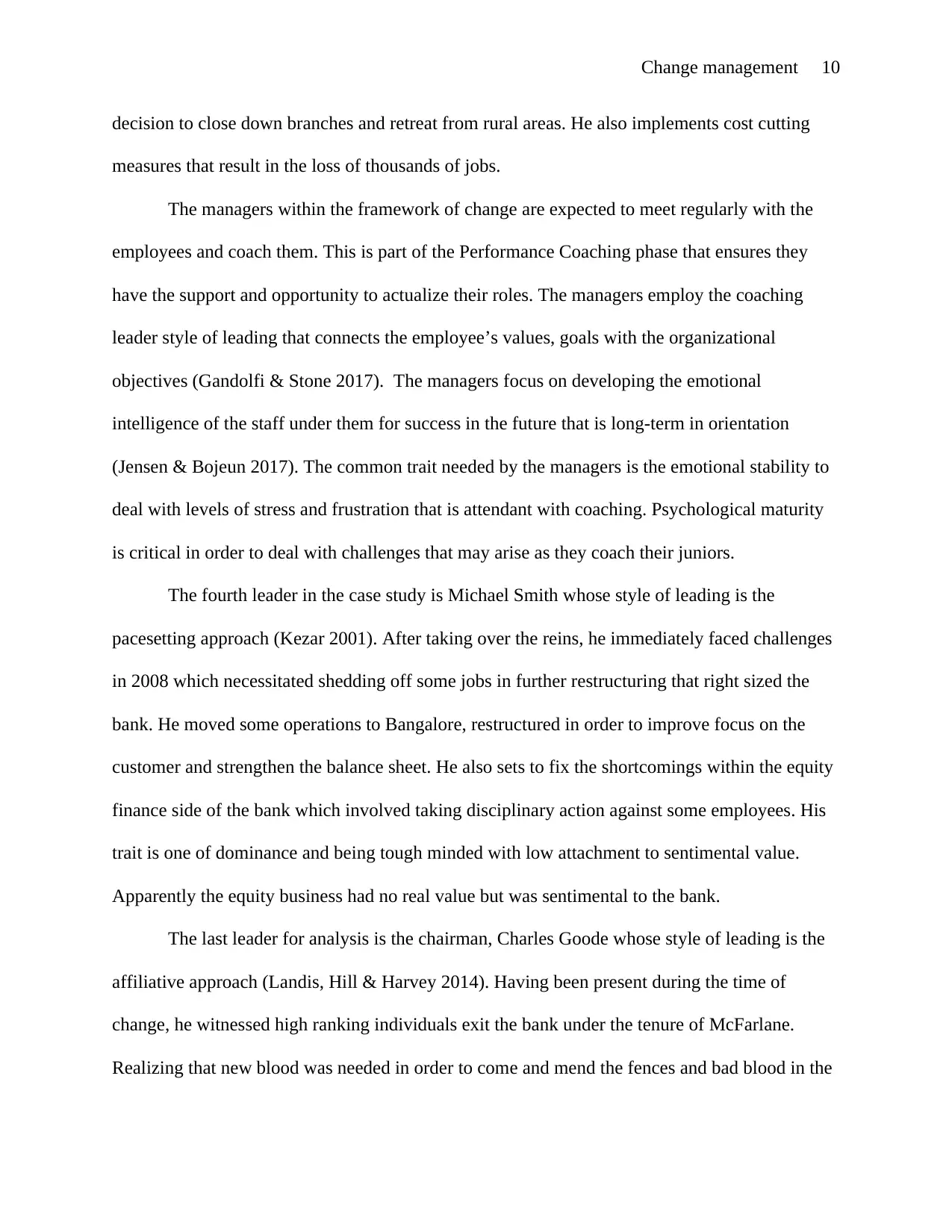
Change management 10
decision to close down branches and retreat from rural areas. He also implements cost cutting
measures that result in the loss of thousands of jobs.
The managers within the framework of change are expected to meet regularly with the
employees and coach them. This is part of the Performance Coaching phase that ensures they
have the support and opportunity to actualize their roles. The managers employ the coaching
leader style of leading that connects the employee’s values, goals with the organizational
objectives (Gandolfi & Stone 2017). The managers focus on developing the emotional
intelligence of the staff under them for success in the future that is long-term in orientation
(Jensen & Bojeun 2017). The common trait needed by the managers is the emotional stability to
deal with levels of stress and frustration that is attendant with coaching. Psychological maturity
is critical in order to deal with challenges that may arise as they coach their juniors.
The fourth leader in the case study is Michael Smith whose style of leading is the
pacesetting approach (Kezar 2001). After taking over the reins, he immediately faced challenges
in 2008 which necessitated shedding off some jobs in further restructuring that right sized the
bank. He moved some operations to Bangalore, restructured in order to improve focus on the
customer and strengthen the balance sheet. He also sets to fix the shortcomings within the equity
finance side of the bank which involved taking disciplinary action against some employees. His
trait is one of dominance and being tough minded with low attachment to sentimental value.
Apparently the equity business had no real value but was sentimental to the bank.
The last leader for analysis is the chairman, Charles Goode whose style of leading is the
affiliative approach (Landis, Hill & Harvey 2014). Having been present during the time of
change, he witnessed high ranking individuals exit the bank under the tenure of McFarlane.
Realizing that new blood was needed in order to come and mend the fences and bad blood in the
decision to close down branches and retreat from rural areas. He also implements cost cutting
measures that result in the loss of thousands of jobs.
The managers within the framework of change are expected to meet regularly with the
employees and coach them. This is part of the Performance Coaching phase that ensures they
have the support and opportunity to actualize their roles. The managers employ the coaching
leader style of leading that connects the employee’s values, goals with the organizational
objectives (Gandolfi & Stone 2017). The managers focus on developing the emotional
intelligence of the staff under them for success in the future that is long-term in orientation
(Jensen & Bojeun 2017). The common trait needed by the managers is the emotional stability to
deal with levels of stress and frustration that is attendant with coaching. Psychological maturity
is critical in order to deal with challenges that may arise as they coach their juniors.
The fourth leader in the case study is Michael Smith whose style of leading is the
pacesetting approach (Kezar 2001). After taking over the reins, he immediately faced challenges
in 2008 which necessitated shedding off some jobs in further restructuring that right sized the
bank. He moved some operations to Bangalore, restructured in order to improve focus on the
customer and strengthen the balance sheet. He also sets to fix the shortcomings within the equity
finance side of the bank which involved taking disciplinary action against some employees. His
trait is one of dominance and being tough minded with low attachment to sentimental value.
Apparently the equity business had no real value but was sentimental to the bank.
The last leader for analysis is the chairman, Charles Goode whose style of leading is the
affiliative approach (Landis, Hill & Harvey 2014). Having been present during the time of
change, he witnessed high ranking individuals exit the bank under the tenure of McFarlane.
Realizing that new blood was needed in order to come and mend the fences and bad blood in the
Paraphrase This Document
Need a fresh take? Get an instant paraphrase of this document with our AI Paraphraser

Change management 11
upper management, he took the approach that people should come first. Having come through a
period that was stressful for all employees, re-mending trust and dissipating tension called for
this style of leading (Choi Sang, Lim Zhi & Tan Wee 2016). The trait exhibited is to be
conscientious to be bound by duty as the chairman to ensure continuity which is harmonious for
the bank. He therefore used his position to push for new leadership despite objections from the
shareholders on the timing.
Conclusion
Organizations often undergo changes in their structure, management and leadership
within the course of doing business. Meaningfully changes that are transformative often require
the use and of different models and theories on change management. The process of change at
ANZ bank under the leadership of McFarlane utilized two concepts and theories of change
management at the organizational level. The Lewin’s model was used to catalyze the
organization to change using broad parameters. The McKinsey 7 S model offers more depth and
insight into the component aspects that were targeted for change. The change resulted in right
sizing the human resource component coupled with cultural change that espoused new
organizational values.
The process of change is fraught with challenges such as the resistance by employees to
change. Other challenges include lack of clear communication which requires change managers
to come up with proactive solutions. Some models that can be employed within organizations to
facilitate a smooth transition of change are the cultural web and ADKAR models. These models
help the employee to align their values and goals to that of the organization. Leaders and their
style of management coupled with personality traits affect the process of change. Each leader
and manager will adopt the style relevant to the stage of change. Collectively, the different
upper management, he took the approach that people should come first. Having come through a
period that was stressful for all employees, re-mending trust and dissipating tension called for
this style of leading (Choi Sang, Lim Zhi & Tan Wee 2016). The trait exhibited is to be
conscientious to be bound by duty as the chairman to ensure continuity which is harmonious for
the bank. He therefore used his position to push for new leadership despite objections from the
shareholders on the timing.
Conclusion
Organizations often undergo changes in their structure, management and leadership
within the course of doing business. Meaningfully changes that are transformative often require
the use and of different models and theories on change management. The process of change at
ANZ bank under the leadership of McFarlane utilized two concepts and theories of change
management at the organizational level. The Lewin’s model was used to catalyze the
organization to change using broad parameters. The McKinsey 7 S model offers more depth and
insight into the component aspects that were targeted for change. The change resulted in right
sizing the human resource component coupled with cultural change that espoused new
organizational values.
The process of change is fraught with challenges such as the resistance by employees to
change. Other challenges include lack of clear communication which requires change managers
to come up with proactive solutions. Some models that can be employed within organizations to
facilitate a smooth transition of change are the cultural web and ADKAR models. These models
help the employee to align their values and goals to that of the organization. Leaders and their
style of management coupled with personality traits affect the process of change. Each leader
and manager will adopt the style relevant to the stage of change. Collectively, the different

Change management 12
leadership styles and models adopted in the process of change ensure that the change is
transformational, beneficial and long-lasting.
leadership styles and models adopted in the process of change ensure that the change is
transformational, beneficial and long-lasting.
⊘ This is a preview!⊘
Do you want full access?
Subscribe today to unlock all pages.

Trusted by 1+ million students worldwide
1 out of 15
Related Documents
Your All-in-One AI-Powered Toolkit for Academic Success.
+13062052269
info@desklib.com
Available 24*7 on WhatsApp / Email
![[object Object]](/_next/static/media/star-bottom.7253800d.svg)
Unlock your academic potential
Copyright © 2020–2025 A2Z Services. All Rights Reserved. Developed and managed by ZUCOL.




